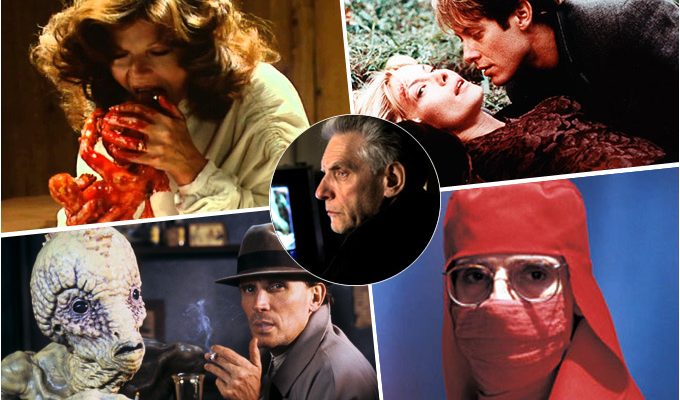 “A Dangerous Method” (2011)
“A Dangerous Method” (2011)
David Cronenberg is not just an auteur — he’s a dynamic storyteller, something can shine through even when he’s tacking films that do not at first blush appear to be within his auteurist wheelhouse. In “A Dangerous Method,” he employs all of that flair, twisting and tweaking the structure of this curious psychodrama in ways no other director would approach. Depicting the professional tensions between Carl Jung (Michael Fassbender) and his mentor Sigmund Freud (Viggo Mortensen), and Jung’s flirtation with student/patient Sabina Spielrein (Keira Knightley), he juxtaposes the straight-laced nervousness of Jung, the cigar-chewing (natch) boldness of Freud and the bedroom dysfunction of the genuinely tortured Spielrein. But he’s also having a wry laugh at the proceedings, depicting Freud as a psychological bully who treats everyone as his test subjects, and Jung as the whimsical genius who starts to credit his own mind-powers almost as a reflexive response to Freud’s subtle bullying. “A Dangerous Method” divided Cronenberg fans who couldn’t grasp where it settled on the spectrum between starchy, talky period film and kinky Cronenbergian sexual melodrama. But once again, he is exploring the horrors of the body (Jung is almost repulsed by his own longings) in a way both subtle and perversely overt. Whether that synthesis spices up a conventional, talky period drama, or simply renders the film less successful as a period drama, is an ongoing debate, as is Knightley’s physical, gurning performance. It’s a hard film to adore, but an impossible one to dismiss: perhaps appreciating its strengths from an appropriately analytical remove is the only right answer. [B]
 “Cosmopolis” (2012)
“Cosmopolis” (2012)
After the comparatively mainstream one-two punch of “A History of Violence” and “Eastern Promises,” “Cosmopolis” both is and isn’t a return to the Canadian body horror auteur’s more transgressive roots. To be sure, this opaque, occasionally frustrating adaptation of Don DeLillo’s steel-edged novel is anything but mainstream, featuring proctology exams conducted in limousines, resentful protesters brandishing dead rats in city streets and, in the final stretch of the film, some truly gruesome Cronenbergian violence. And yet, while the director has always employed a sort of clinical remove from his characters, his view of this movie’s central protagonist – Eric Packer, played with a minimal affectations and a disarming, ghostly pallor by Robert Pattinson in what many consider to be his first respectable role – is practically anemic, even lifeless at points. Packer spends the film’s runtime crawling across a vaguely apocalyptic New York City in a limo on his way to a haircut, and the character fits in snugly with the archetypical Cronenberg antihero. He’s morose, cynical, enthralled by sex, death and technology. Pattinson commits to his character’s non-identity admirably, although the hermetically congealed alternate universe in which “Cosmopolis” unfolds is ultimately more distancing than compelling. It isn’t until the film’s haunting third act, which features a mesmerizing scene set in Packer’s favorite childhood barbershop and the murderous advances of a disgruntled blue-collar nut named Benno Levin (Paul Giamatti, grizzled and shouting quite a bit) that “Cosmopolis” hints at the great, daring satire that it might have been. DeLillo die-hards may dig it, and fans of Cronenberg’s should give it a go just for curiosity’s sake, but sadly, “Cosmopolis” is a far cry from the director’s great, early work. [C]
 “Maps to the Stars” (2014)
“Maps to the Stars” (2014)
Tinseltown has never seemed more rancid then in “Maps to the Stars”, a fiendish, mostly brilliant and thoroughly off-putting Hollywood ghost story. Cronenberg’s career making movies is going on four decades now, touching on everything from low-budget body horror to operatic period pieces, beat generation adaptations and straight-up crime films, and his signature brand of chilling alien deadness remains one of the most singularly disorienting cinematic experiences one can be exposed to. He remains typically fascinated with the human body as a horror show but this time around, he’s more taken with the literal possibilities of incest and the metaphysical aspects of death and love. “Maps” opens on a young, boyish-looking woman (Mia Wasikowska) on a Greyhound bus headed for Hollywood, California. She wears a hooded sweater that reads “Bad Babysitter” and has horrible burn marks on her neck and long, svelte black gloves covering her arms. Who is she? Without giving too much away, she’s involved in an Ouroboric tangle between some truly hideous, fucked-up people, all of whom we will come to know entirely too well. Julianne Moore lends her proclivity for scenery-chewing to the marvellous, hideously lived-in role of Havana Segrand, a pathetic has-been starlet whose bouts of prescription pill abuse and deviant sex are fueled by her unerring desire to embody the spirit of her mother by starring in the film that made her famous (Havana’s mother was burned in a fire, not a coincidence). Also in the mix are Benji Weiss (Ethan Bird), a vile, hateful child actor and the star of the “Bad Babysitter” franchise, a dim-bulb chauffeur with misguided authorial aspirations (Robert Pattinson) and a self-help guru named Stafford (John Cusack) who privately stews in concealed resentment and rage before disguising it as New Age doublespeak. This is an art film with the soul of a midnight movie, as mordantly funny and brazenly disturbing as Cronenberg was in his prime. [B+]
What’s your take on the many phases of Cronenberg’s career? Let us know in the comments. — Jessica Kiang, Nicholas Laskin, the Playlist Staff.

